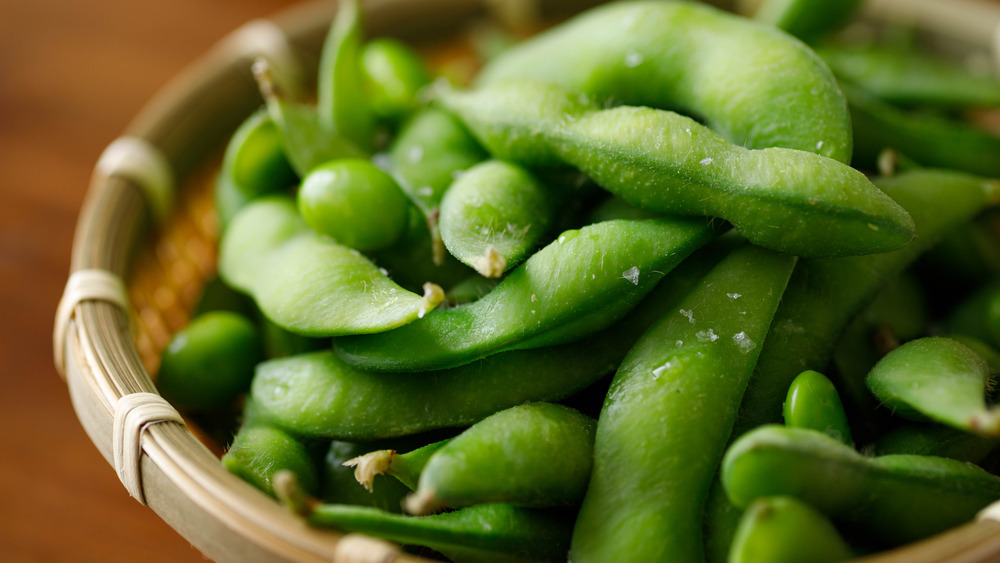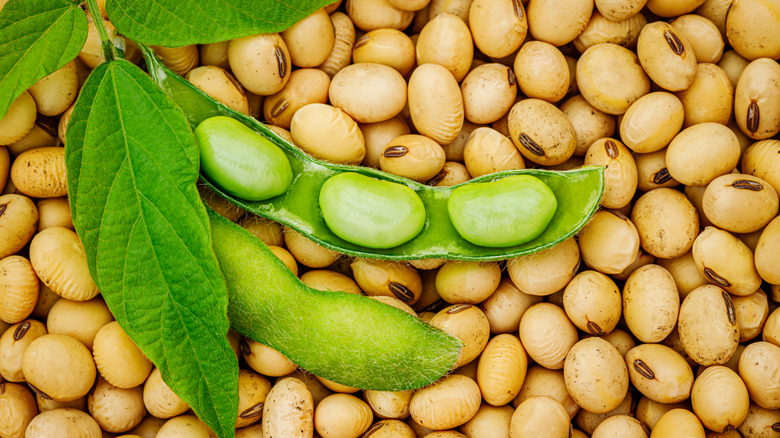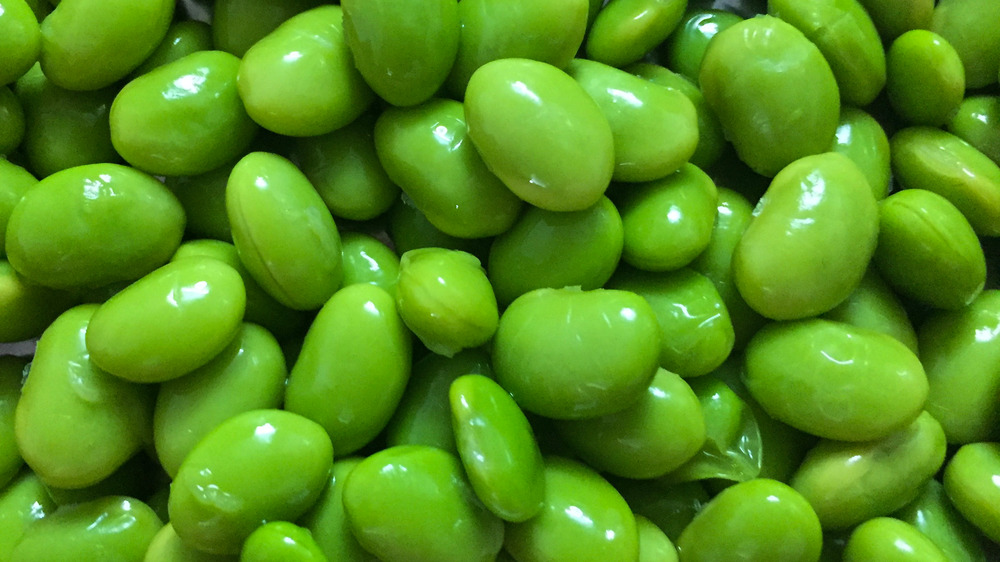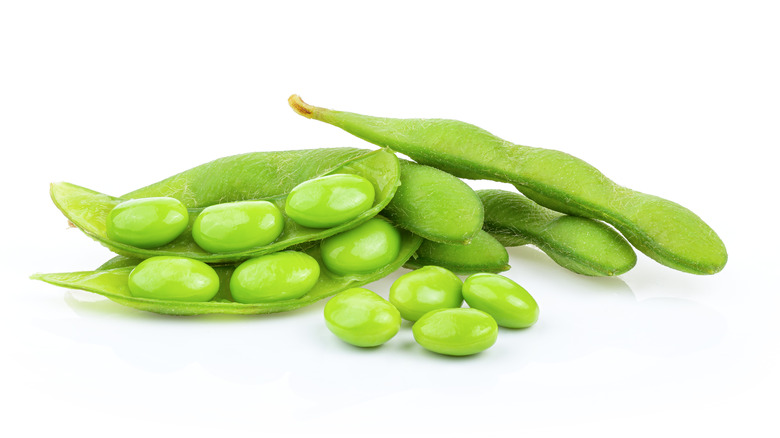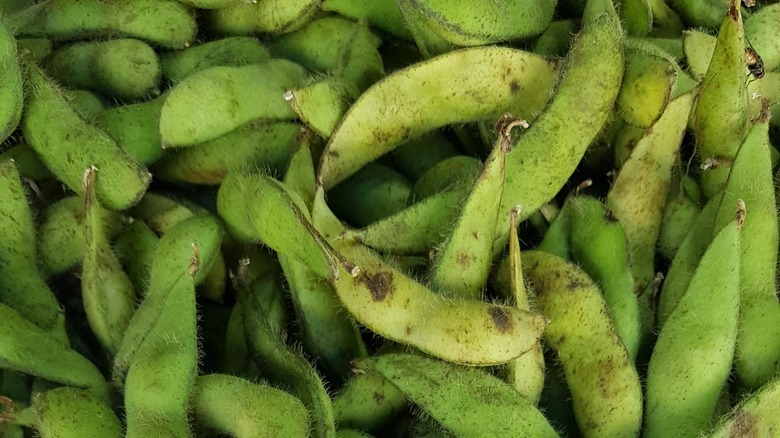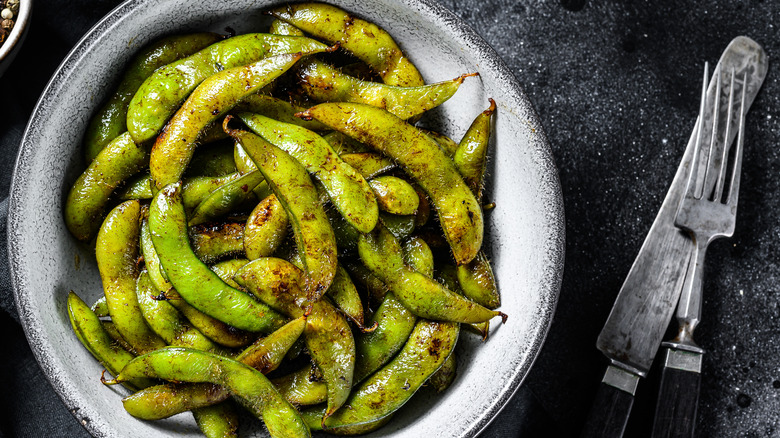What Is Edamame And What Does It Taste Like?
What is edamame? The simple answer is edamame is a soybean. But what's the difference? And why don't we simply call the ingredient soybeans? Although edamame comes from the same plant as soybeans, they're grown and produced differently. Edamame is used in many different Asian cuisines, and the name is derived from the Japanese words for "bean" and "branch," according to Kikkoman. Unlike what we typically think of as soybeans — which are really just edamame pods that are picked when they're harder and mature — these little beans are plucked early. Though you may already have a good idea of what eating and drinking soy products like tofu, tempeh, or soymilk is like, you might be wondering what edamame tastes like.
Soybeans and edamame, regardless of being the same plant, have drastically different flavors. Fully mature soybeans, despite all of their benefits, don't do a whole lot for the palate. Edamame however, can be described as somewhere between an almond and a harder, more modest version of a pea. And if you're looking for more than good taste, edamame has plenty to offer.
Why people started eating edamame
We know soybeans have been around for quite a while. According to Delishably, these plants have been grown in China for more than 7,000 years. As Buddhism began to spread throughout the country, the consumption of soybeans grew alongside it, as Buddhists usually maintain a vegetarian diet so as to not harm any living creature. A great source of protein, soybeans, naturally, became a staple in the Buddhist diet. But for those who didn't necessarily love the intense "beany" taste of soybeans, the outlet explains there was a rather simple answer.
Though there were plenty of processes used to make soybeans a bit more palatable — such as soaking and cooking them down into what would eventually become tofu — the most simple soy hack was to pick the pods slightly before full maturity. If you haven't already guessed, this is how to make edamame. By harvesting them earlier, soybeans actually lose some of the strong bean flavor soy was associated with.
The health benefits of edamame
According to Healthline, there are numerous health benefits (as well as a couple of concerns and myths) when it comes to edamame. Benefits range from possibly reducing the chances of breast cancer to lowering blood pressure to reducing the effects of menopause. The beans are also chock-full of essential vitamins and minerals. And don't think they're the same as soybeans — edamame has more folate and vitamin K than its older kin.
While there are some concerns regarding the regular consumption of soy, as Healthline points out, the major selling point for this little green legume is it is an excellent (and vegan) source of protein. Where most plants have very little protein, edamame contains almost 20 grams per cup, and on top of that, it boasts an array of amino acids, which is a major plus for anyone, but especially those who don't get protein through animal sources. If that's not a superfood, we don't know what is.
Is there a reason to avoid edamame?
While edamame may be packed with all sorts of natural goodness, there are a few common concerns when it comes to this little green treat. While some people are worried about ingesting genetically modified organisms (GMOs), GMO soy isn't the only thing you may want to be aware of. Today's Dietitian shares there are high amounts of oxalates and other antinutrients present in edamame. (Antinutrients are present in all soy-based foods, but, due to being "minimally processed," edamame can have higher levels than things like tofu or soy sauce.) These naturally occuring compounds can cause kidney stones and "interfere with nutrient absorption."
Though this might sound frightening, there isn't much reason to worry if you have a balanced diet. The outlet consulted with dietitian Taylor Wolfram, MS, RDN, LDN, who specalizes in vegan diets. Wolfram shared that she just makes sure her clients who consume a lot of soy aware of any potential issues so they know what to look out for and how to combat any negative side effects. The bottom line is, even if you frequently eat edamame, it shouldn't cause significant health problems unless you're piling them on the plate for every meal.
Where to buy edamame and what to look for
These days, edamame isn't so difficult to find, typically sold at most local grocery stores in the produce aisle or frozen. Though you can find edamame rather easily, it's important to know what to look for when buying the fresh bean pods. What you should certainly stay away from is black or brown edamame: black coloration means it's already rotten, while a brown color isn't quite as bad, but means that the pods are on the older side and should probably be eaten ASAP.
So what should you look for when scouring your local produce aisle for edamame? You'll want a pod between one to three inches long, with two or three plump-looking beans inside. This is a sign that the beans are ready to be eaten. Another sign to look for is that there's a decent amount of fuzz on the pod: too much or too little could either mean the pod is already starting to go bad or that it hadn't reached its proper point of maturity before harvesting.
How to eat edamame
One of the best things about edamame is just how simple it is to prepare. Of course, there are a million ways to utilize edamame, but its simplicity is a thing of beauty. Just One Cookbook spells out just how easy they are to cook. The first thing they reccomend you do is snip the ends off of each side of the pods. This way, when cooking them, the salt from the water enters the pod and further absorbs into the beans. You can also steam the bean pods instead of boiling if you prefer. After that you want to rub them in salt to remove some of the fuzz, plus add a little more salt to the beans. Scrape the pod between your teeth, allowing the beans to fall out into your mouth — similar to how you eat an artichoke petal.
Other than simply steamed or boiled and salted, you can make spicy garlic edamame with the addition of some garlic, soy sauce, sesame oil, and chili paste, or try adding the beans (removed from their pods, of course) to fried rice. Edamame is also great added to lo mein, in rice bowls, or as a nutritious side for almost any meal.
